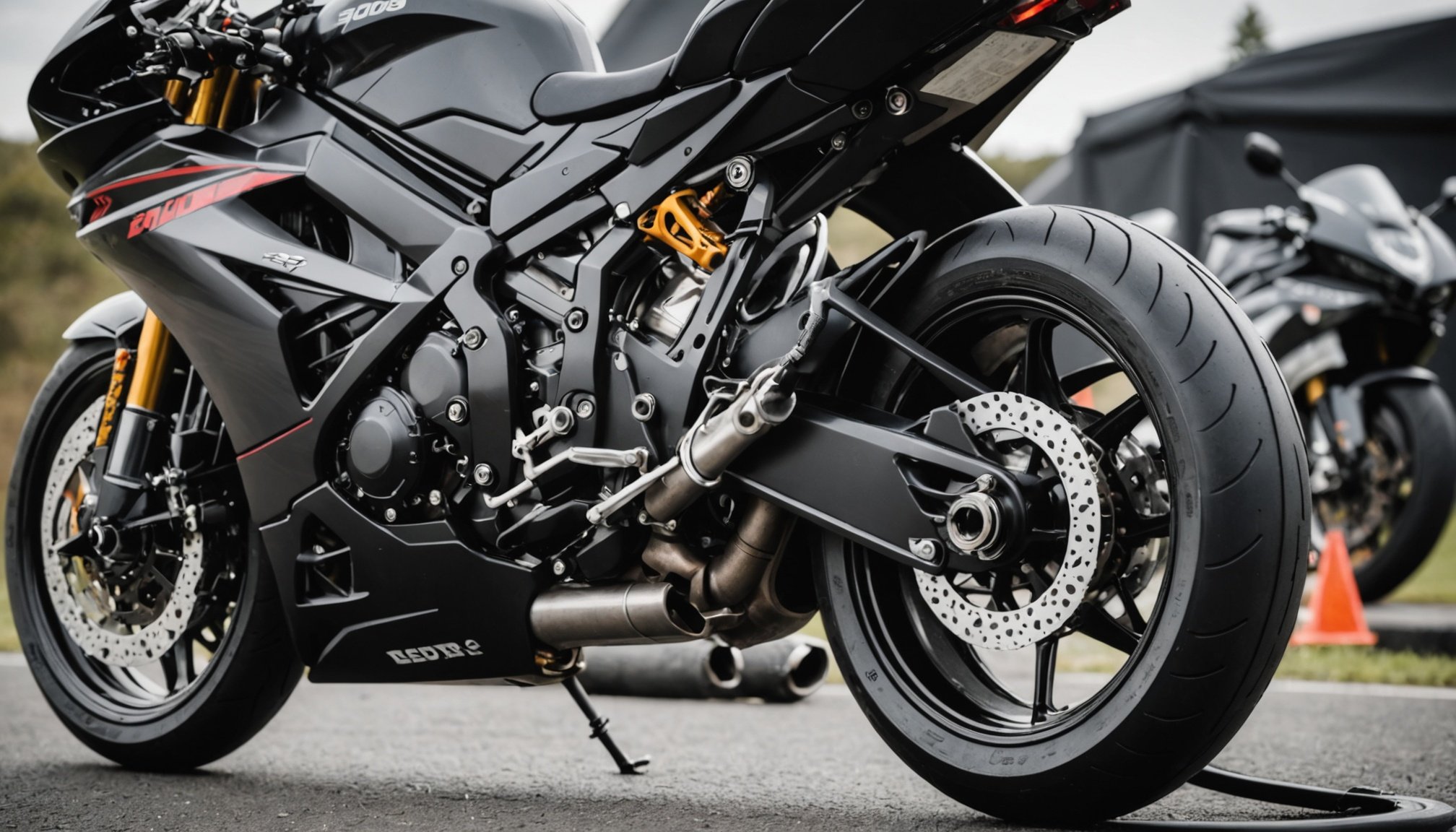Understanding Climate Impact on Tire Lifespan
The influence of UK weather significantly impacts tire longevity due to its diverse climate patterns. Frequent rain and relatively humid conditions can accelerate tire wear, reducing overall lifespan. Tires exposed to these conditions often face challenges such as reduced grip and increased abrasion. It is crucial to understand that seasonal changes, particularly in the UK, affect tire material.
During colder months, tires may become more rigid, which can lead to increased wear if not properly managed. On the other hand, warmer temperatures can soften tires, affecting their performance factors and causing them to wear out more quickly on hard surfaces.
Topic to read : Expert Tips for Perfect Sport Bike Tire Inflation in the UK’s Shifting Weather
Riders must adapt their habits to the varying climates to ensure optimal tire performance. This includes taking into account the UK riding conditions by moderating speed and avoiding harsh braking during extreme weather. Additionally, checking tire pressure regularly is vital, as fluctuating temperatures can alter tire inflation levels, subsequently affecting longevity.
Embracing strategies such as rotating tires seasonally and selecting tires suited for specific weather conditions can also contribute to extended tire life. Adjustments in riding style to accommodate for different environments are equally important. These climate effects are integral to maintaining tire efficiency and maximizing their lifespan.
Also to read : Unlocking tank grip techniques: elevate your sport bike handling skills in the uk
Routine Tire Maintenance Practices
Effective tire maintenance is paramount for ensuring their longevity. Regular inspections are key; always observe for signs of wear and tear such as uneven tread or foreign objects lodged in the rubber. These inspections help in early detection of issues that, if left unchecked, could lead to more significant problems.
Cleaning practices are another crucial aspect of tire care. Use water and mild soap to clean the tires thoroughly, removing debris that could cause abrasion or deterioration. It’s essential to avoid harsh chemicals that might degrade the rubber compounds.
When it comes to addressing tire damage, early intervention is vital. Check for cracks, bulges, or punctures routinely. A small puncture can often be repaired if caught early, but if ignored, it could lead to a full tire replacement.
Developing a habit of using basic tire care techniques will not only ensure safety on the road but also maximise the tire’s lifespan. Detailed attention to such practices helps maintain tire performance, allowing for optimal riding experiences across varied UK weather conditions. Regularly engaging in these maintenance routines can save costs and enhance safety, making them an indispensable part of riding rituals.
Optimal Riding Techniques for Longevity
Prolonging tire life is not just about maintenance; it also involves adopting riding tips for longer tire life. For sport bike enthusiasts, mastering efficient riding styles is essential. Engaging in techniques like smooth acceleration and braking can significantly minimize tire wear. By applying gradual throttle and avoiding sudden bursts, riders can prevent unnecessary strain on their tires.
Sport bike handling requires finesse, especially in preserving tire condition. High-performance riding often demands precision, yet this doesn’t have to equate to increased wear. By adjusting your riding approach according to road conditions, the riding impact on tires may be reduced, enhancing tire durability.
Understanding the dynamics of cornering and speed moderation plays a vital role in reducing tire abrasion. Riders should emphasize maintaining a balance between agility and restraint, especially in varying road conditions. Ensuring consistent tire contact with the road during maneuvers can help sustain tire lifespan.
Moreover, altering your riding methods based on terrain can contribute to longevity. For instance, on wet or slippery surfaces, adopting a more cautious stance avoids excess tire friction. Integrating these strategies not only extends tire life but also promotes safer riding experiences.
Tire Inflation Guidelines
Maintaining correct tire pressure is crucial for both tire performance and longevity. It’s a delicate balance that every rider should be aware of. Incorrect pressure settings can lead to decreased control, and underinflation specifically can cause tires to wear unevenly, leading to a shorter lifespan.
It’s essential to regularly check tire pressure. But how often should this be done? Once a week is generally advised for most riders to avoid any significant deviations. When checking, ensure the tires are cold to get the most accurate readings, as heat can increase pressure temporarily.
You might wonder, what happens if tire inflation is neglected? Underinflated tires flex more, generating excessive heat, which breaks down tire components. This not only reduces lifespan but also increases the risk of a blowout—a dangerous situation best avoided.
Adapting to changing conditions, the recommended tire pressure can vary. For example, in colder climates, slightly higher pressure might be necessary to compensate for temperature fluctuations. Always refer to the manufacturer’s guidelines, which often provide detailed recommendations for varying conditions, helping you maintain safety while extending your tires’ life.
Recommended Tire Brands for UK Conditions
The diverse UK climate demands tires that can withstand the best sport bike tires UK needs. Understanding which brands offer reliability under these conditions requires careful tire brand comparisons. Top choices include Michelin, Bridgestone, and Pirelli, each delivering superior performance and durability. For instance, Michelin’s Road 5 is renowned for excellent wet grip, which is critical given the UK’s frequent rainy conditions.
Comparing performance, Michelin is noted for longevity and supreme wet handling, while Bridgestone offers robust options for sport touring with its Battlax series. Pirelli’s Diablo Rosso range excels in delivering responsive sport bike handling—a worthy mention when considering reliable tire options.
User reviews often highlight personal experiences, praising Pirelli’s dynamic performance and Bridgestone’s mileage durability. Expert recommendations align, often suggesting these brands for various UK riding scenarios.
Choosing the right tire brand involves balancing cost, performance, and specific riding needs, emphasizing the importance of informed selections. Adhering to such advice ensures optimal riding experiences throughout changing UK weather, enhancing both safety and enjoyment. By investing in renowned brands, riders not only improve performance but also contribute to extended tire longevity.
Common Mistakes to Avoid
Understanding tire care pitfalls ensures you maximise the longevity of your tires. Riders often overlook crucial aspects, such as neglecting regular inspections. Always schedule consistent checks for wear and damage, including observing tread depth and looking for punctures or debris. A small oversight now can mean substantial expenses later.
Maintenance errors like improper tire inflation are common. Incorrect pressure can lead to uneven wear and increased risk of blowouts. Always refer to manufacturer guidelines. Some riders also ignore cleaning, but using gentle methods can prevent deterioration without damaging tire compounds.
When it comes to riding mistakes, harsh acceleration and braking top the list, contributing to rapid tire wear. Practice smooth, gradual maneuvers to minimise stress on your tires. Additionally, excessive cornering speeds can accelerate abrasion, so adjust speed to match road conditions for optimal tire durability.
Riders often skip the importance of manufacturer guidelines, crucial for maintaining tire health. Adhering to these instructions not only enhances performance but also significantly extends tire life. These avoidable mistakes, if addressed, improve safety and keep your riding experience seamless across the diverse UK climates.
Seasonal Considerations for Tire Care
Adapting to the UK’s ever-changing climate involves strategic seasonal tire preparation to ensure both safety and performance. Understanding when to alternate between winter vs summer tires can significantly impact tire lifespan. Winter tires are engineered with special tread designs and rubber compounds that remain pliable in cold conditions, enhancing grip on icy roads. Alternatively, summer tires offer robust performance on dry and wet roads but can harden and lose traction in the cold.
All-weather tire advice can be beneficial for riders who prefer a single solution throughout the year. These tires combine elements of both winter and summer varieties, providing versatility across a broader range of temperatures and conditions. However, it’s essential to realise that while they offer convenience, they may not match the specialised performance of season-specific options.
It’s crucial to prepare tires for winter riding conditions by inspecting tread depth and checking for any wear and tear that might compromise performance. Adjusting inflation pressure is another key step, as colder temperatures can reduce tire pressure, impacting handling and safety. By investing time in seasonal tire care, riders ensure reliability and maximise the efficiency of their motorcycles year-round.
FAQs and Quick Troubleshooting
Moving swiftly to frequently asked questions can demystify your tire concerns. Tire care FAQs address the crux of daily dilemmas. For instance, “How often should I inspect my tires?” Weekly visual checks ensure safety and longevity. These inspections help detect early signs of damage, such as inadequate tread or foreign objects.
When you encounter common tire issues like punctures or uneven wear, quick tire troubleshooting becomes essential. A straightforward fix like using a tire sealant can temporarily repair a puncture, allowing a safe journey to a professional. Uneven wear often signals misaligned wheels or incorrect pressure, both rectifiable with regular maintenance.
Wondering when to seek professional assistance? If extensive damage, like bulging sidewalls or recurring air loss, appears, it’s critical to consult experts. Such professionals possess the expertise to perform detailed assessments and recommend whether repair is feasible or if replacement is required.
These insights on tire care FAQs can be your guide to maintaining road safety and efficiency. By addressing issues promptly and consulting professionals when necessary, the lifespan of your tires can be significantly enhanced, ensuring a smoother riding experience.





